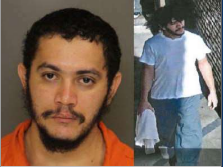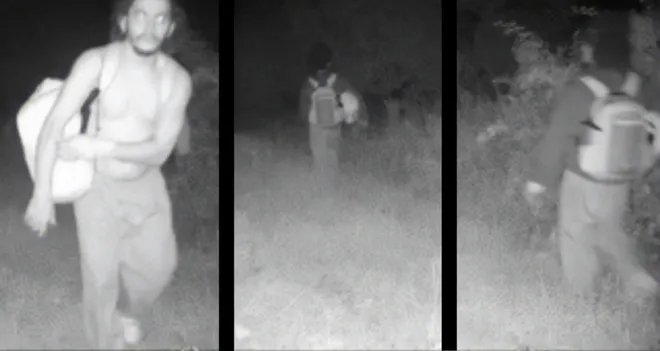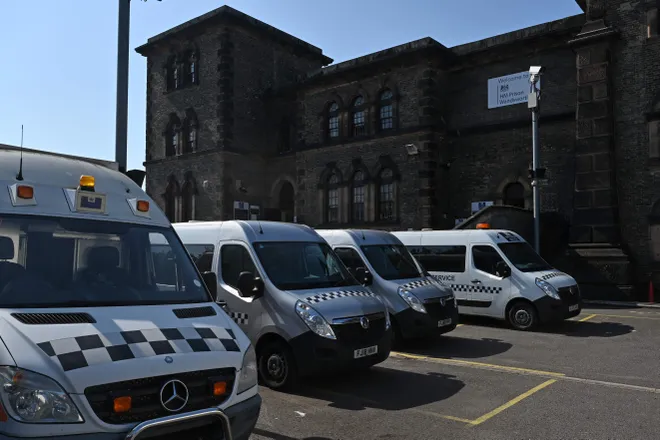Danelo Cavalcante has eluded police for 9 days now. What will it take for him to get caught?
Though three prisoners managed to escape custody in the last two weeks, the odds of maintaining their freedom are overwhelmingly against them, an expert says.
Danelo Cavalcante, imprisoned for killing his ex-girlfriend Deborah Brandao in front of her two children, has eluded hundreds of law enforcement agents who've bore down on small suburban communities in southeastern Pennsylvania. Cavalcante, 34, escaped the Chester County Prison by, in part, crab-walking up a wall, passing over a roof and blasting through razor wire on Aug. 31.
On Wednesday, Daniel Abed Khalife – a former British soldier awaiting trial on charges of planting fake bombs, and accused of attempting to leak information to Iran – snuck out of a London prison, sparking a country-wide manhunt. Khalife, 21, got out by allegedly strapping himself to the bottom of a food delivery truck. He was reported to have escaped wearing a chef’s uniform.

The same day as Khalife's escape, a homicide suspect and hospital patient in Washington D.C., Christopher Haynes, fled from George Washington University Hospital.
All three men remained at large early Friday.
How long a fugitive can elude capture can depend on how much planning went into their escape, said Anthony Cangelosi, an adjunct professor at John Jay College of Criminal Justice and a former U.S. Marshal and Secret Service agent.
If they put a significant amount of time into the plan, they are usually motivated to not get caught.
In Cavalcante’s case, his motivation to escape was high, Cangelosi said; he’d just been sentenced to life in prison without parole and he was pending transfer to a state prison.
“You have a very desperate individual there. He doesn’t want to spend the rest of his life in jail, and he’ll probably take extreme measures to get away,” Cangelosi said. “I wouldn’t think this guy’s going to surrender easily.”
Fugitive manhunts sometimes end in suicide, violence if the fugitive uses force to steal a car, or a confrontation with law enforcement could lead to the escapee's death, Cangelosi said.
“In the Marshal Service, they teach in the Academy, every prisoner thinks about escape at some time or another, particularly if they’re doing a significant amount of time,” he said. “Whether or not they go through with the plan is another story, but they think about it – they’ve got a lot of time on their hands.”
Prison breaks relatively rare
Research on prison escapes is scarce. However, one study published in 2016 analyzed over 500 prison escapes in 2009 and discovered the wide majority of escapees, over 92%, were captured. And most of them, research shows, fled low-security facilities seemingly on a whim – making the escapes of Cavalcante and Khalife standouts.
Bryce Peterson, the researcher whose team conducted the report, previously told USA TODAY prison escapes, while uncommon in general, usually happen in low-security and locally-run facilities. In many cases, offenders may simply walk away, or don’t return if they’re out on a work release.
“That happens much more frequently than people breaking out of a facility, overcoming a barrier, overcoming a guard,” said Peterson, an adjunct professor at John Jay College of Criminal Justice and senior research scientist at the CNA Center for Justice Research and Innovation.
It is, however, hard to estimate how many prison breaks happen in the U.S. because there’s no comprehensive national data on them, he said.
Violence by escapees is uncommon
Peterson said in his research, less than 9% of escapees used violence in the community. He added one caveat: the more motivated someone is to stay out, the more likely they are to use violence.
Cavalcante's pending transfer to a state facility could have been a “catalyst event” prompting his escape, which Peterson said makes him more motivated to not get caught.
“The two things that are important are: It’s unlikely he will use violence – not to say it can’t happen,” Peterson said. “Almost always in these situations … people are going to get caught.”

Hunt for Cavalcante enters day nine
Cavalcante's escape has raised criticism about the prison’s security considering Cavalcante used the same route as another inmate who escaped the facility in May before being caught just minutes later.
Chester County Prison officials did not immediately return USA TODAY's request for comment on Friday.
At a press conference Thursday afternoon, authorities said Cavalcante was last spotted just east of the Longwood Gardens – a popular attraction in Chester County. This is the second sighting for the escaped prisoner near the attraction, who was also seen on trail footage at the garden on Monday.
The perimeter of the exhaustive manhunt has shifted over the last week as residents and, in one case, law enforcement report sightings. The search has brought hundreds of law enforcement officers to southeastern Pennsylvania, disrupting the lives of thousands of residents. Business has slowed and two school districts canceled classes for two days before partially reopening Thursday.
The reward for information leading to Cavalcante’s arrest is up to $20,000, as of Wednesday.
Cavalcante, a Brazilian native, illegally immigrated to the United States after a warrant was issued in Brazil for his arrest in connection with a 2017 murder. The fugitive was at Chester County prison temporarily awaiting transfer to a state facility when he fled.
A former agricultural worker, Cavalcante is considered to be extremely dangerous. Officials have been authorized to use deadly force against Cavalcante if he is seen and does not surrender, Pennsylvania State Police Lt. Col. George Bivens has said.
Cangelosi said investigators are probably looking into Cavalcante’s history to figure out who could potentially help him. They will likely check prison records to see who visited him recently and who had phone conversations with him.
They would likely visit those people and see if they knew anything about his whereabouts, he said.

Prisoner strapped himself under delivery truck
Authorities did not know how Khalife managed to escaped the Wandsworth prison until, when searching a food delivery truck, they discovered strapping underneath it, according to a statement Alex Chalk, British secretary of state for justice.
Since the escape, police in London began searching Richmond Park, the largest of the city's Royal Parks, near the last location of the van that Khalife used to break out of prison.
Khalife, a former soldier stationed at MOD Stafford military base, is believed to have attempted to provide information to Iran, the BBC reported. He was awaiting trial on terror charges for sparking a false threat of an attack by planting fake bombs on the base. He allegedly placed three canisters with wires on the base, simulating a bomb, according to court documents viewed by Al Jazeera.
Police have dispatched a special team to track down Khalife and have asked the public to inform them immediately if they see him.
“I am urgently appealing to the public to help us find Daniel Khalife, who could be at large anywhere in the U.K.,” said Metropolitan Police Counter Terrorism Commander Dominic Murphy in a statement posted to X, formerly know as Twitter, on Wednesday.
Murder suspect flees university hospital
Haynes was arrested on Wednesday in Virginia on a warrant related to a D.C. area homicide from August, according to a news release from the Washington Metropolitan Police Department.
When he was being processed, Haynes complained about ankle pain from a pre-existing injury and was taken to George Washington University Hospital for treatment.
While an officer was changing out his handcuffs, Haynes "physically assaulted the officer and fled from the hospital," according to police. Two officers chased after him but were unable to capture him. The hospital was put under a shelter-in-place order through the evening.
Police released an image of Haynes from a resident's security camera showing the murder suspect without shoes. Black handcuffs were hanging from his right wrist.
The combined total rewards for information leading to Haynes' capture was at $25,000, as of Thursday.
Haynes' Wednesday arrest was in connection with a homicide that occurred in the Northeast Washington neighborhood on Aug. 12. According to the Washington Post, two men were shot: Brent Hayward, 33, was pronounced dead at the scene, and the other was taken to a hospital with life-threatening injuries.
Contributing: Cybele Mayes-Osterman, USA TODAY
Disclaimer: The copyright of this article belongs to the original author. Reposting this article is solely for the purpose of information dissemination and does not constitute any investment advice. If there is any infringement, please contact us immediately. We will make corrections or deletions as necessary. Thank you.


